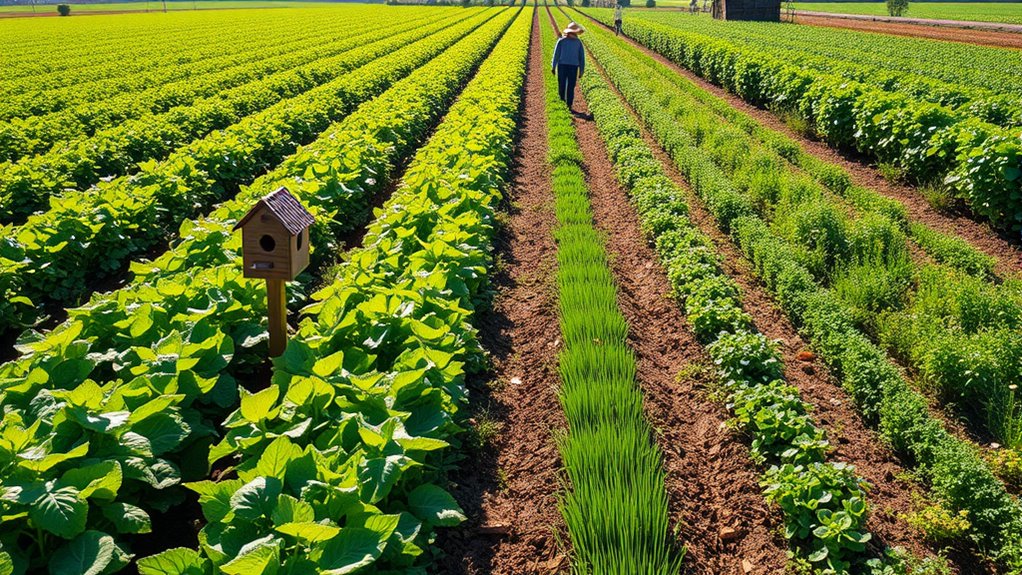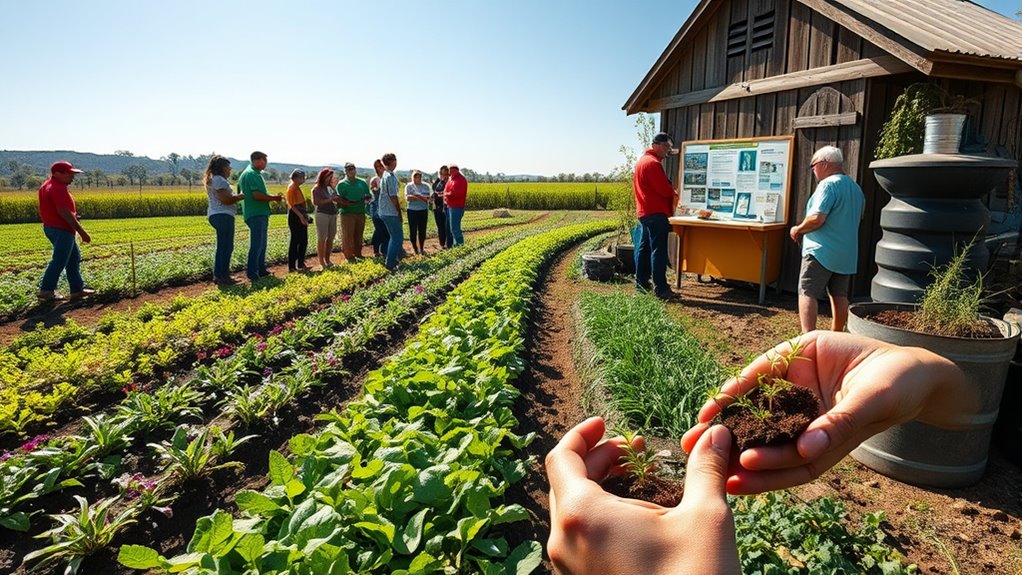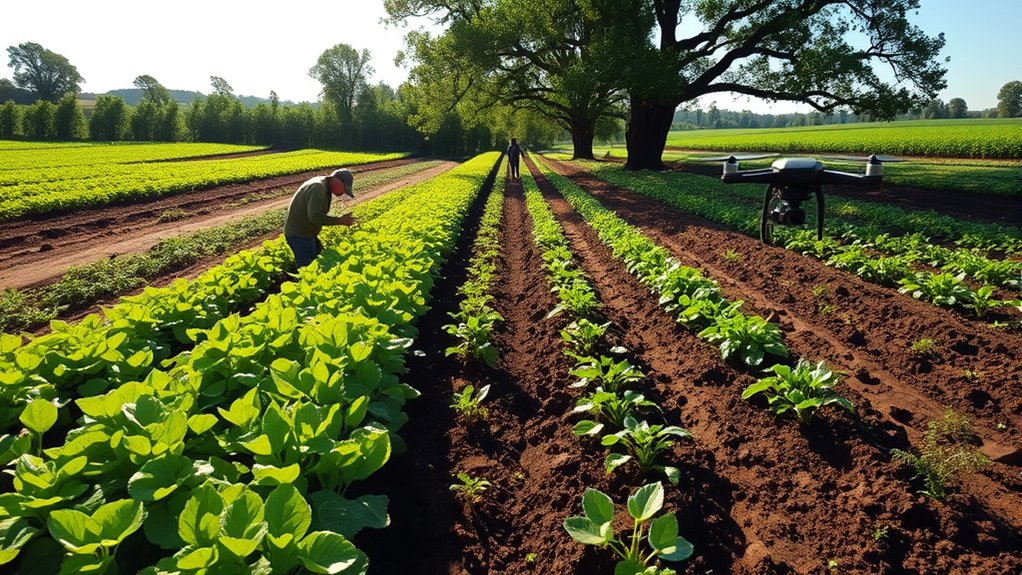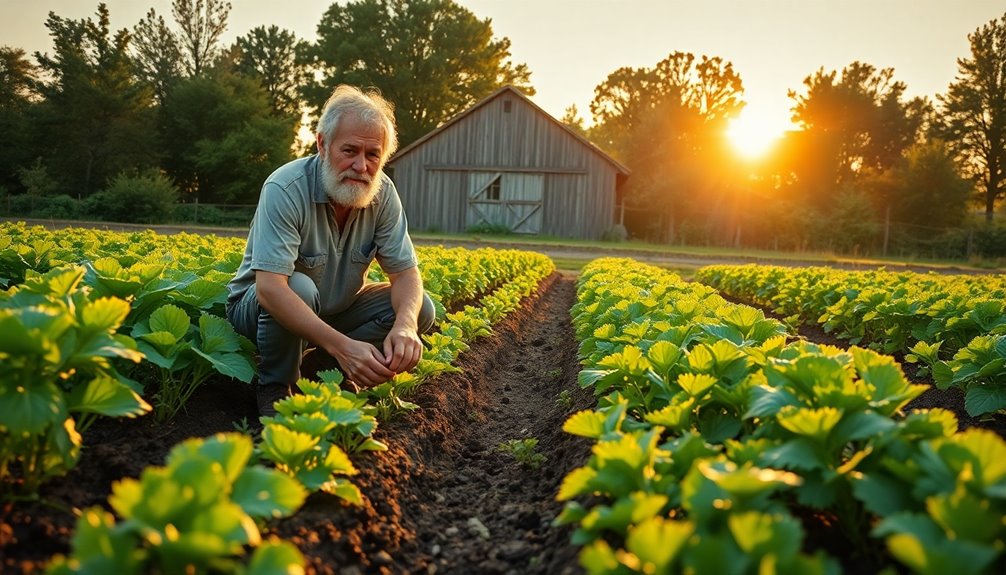Integrating regenerative agriculture into your current farm involves evaluating your practices, building soil health with cover crops and reduced tillage, diversifying crops, and managing resources wisely. Focus on composting, organic amendments, and natural pest control methods like integrated pest management. Improve water conservation through proper drainage and habitat diversity to attract beneficial insects. Continuously monitor your system’s health and stay connected with community resources—these steps set you on a path to a resilient, sustainable operation that evolves over time.
Key Takeaways
- Conduct a baseline assessment of current soil health, crop diversity, and resource use to identify improvement areas.
- Gradually adopt cover cropping, reduced tillage, and crop rotation to enhance soil fertility and ecosystem resilience.
- Implement integrated pest management and minimize chemical inputs to protect biodiversity and promote natural pest control.
- Enhance water retention and runoff management through contour farming, organic amendments, and habitat diversification.
- Engage with local networks, monitor progress regularly, and adapt practices based on data and community collaboration.
Assessing Your Current Farming System and Identifying Opportunities

Before shifting to regenerative agriculture, you need to evaluate your current farming system thoroughly. Start by analyzing your soil health, crop diversity, and resource use. Identify practices that deplete nutrients or cause erosion, and note areas where you see potential for improvement. Review your crop rotation schedules, tillage methods, and chemical inputs. Recognize which practices may hinder soil vitality and which could support more sustainable outcomes. It’s also essential to assess your water management, pest control strategies, and economic viability. This honest evaluation helps you pinpoint weaknesses and opportunities, creating a clear baseline. Additionally, understanding your current system’s input management can reveal where excessive or inefficient resource use occurs. By understanding your current system’s strengths and limitations, you can develop targeted strategies that gradually shift your operation toward regenerative principles. This foundational step guarantees a smoother transition and better long-term results.
Building Soil Health Through Cover Crops and Reduced Tillage

Using cover crops can boost your soil’s fertility and protect it from erosion, while reducing tillage helps preserve soil structure. By adopting these strategies, you support soil microbial activity, which is essential for nutrient cycling. Together, they create healthier, more resilient land for your farm. Implementing soil health practices such as cover cropping and minimal tillage can also enhance carbon sequestration, contributing to climate change mitigation.
Cover Crops Benefits
Have you ever considered how cover crops can transform your soil health? They offer numerous benefits that strengthen your farm’s sustainability. First, they improve soil structure by increasing organic matter and promoting aeration. Second, cover crops help prevent erosion, keeping your topsoil in place during heavy rains. Third, they suppress weeds naturally, reducing reliance on herbicides. Fourth, cover crops fix nitrogen, enriching soil fertility without synthetic inputs. Additionally, they support beneficial microorganisms that enhance nutrient cycling. By incorporating cover crops, you create a resilient soil ecosystem that boosts crop yields and reduces input costs. This natural approach not only enhances productivity but also contributes to long-term sustainability of your farm operations. Eye patch benefits can be compared to cover crops in that both provide targeted, natural improvements to a specific area—whether it’s the skin or the soil—making them essential tools in holistic health and sustainability strategies.
Tillage Reduction Strategies
Incorporating cover crops naturally leads to reduced tillage, which benefits soil health by minimizing disturbance. Less tillage preserves soil structure, reduces erosion, and maintains organic matter. To implement tillage reduction, start by planting cover crops that protect the soil during off-season periods, preventing weeds and reducing the need for mechanical disturbance. Use no-till or minimum-till equipment to plant directly into cover crop residues. This approach encourages the development of a stable soil ecosystem and promotes water retention. Over time, reduced tillage allows natural soil processes to flourish, increasing fertility and resilience. Incorporating organic matter through cover cropping enhances soil vitality and supports regenerative practices. Consistent use of cover crops combined with minimal soil disturbance helps you build a healthier, more productive soil system aligned with regenerative principles.
Soil Microbial Activity
When you adopt cover crops and minimize soil disturbance, you foster a vibrant microbial community that is essential for soil health. These microbes decompose organic matter, fix nitrogen, and improve nutrient cycling. To support soil microbial activity, focus on these key actions:
- Plant diverse cover crops to boost microbial diversity.
- Reduce tillage to preserve microbial habitats.
- Maintain continuous cover to provide a steady food source.
- Avoid synthetic chemicals that harm beneficial microbes.
Additionally, promoting soil organic matter is crucial for sustaining microbial populations and enhancing overall soil fertility.
Incorporating Diverse Crop Rotations for Enhanced Biodiversity

To boost biodiversity and improve soil health, diversifying crop rotations plays a crucial role in regenerative agriculture. By rotating different crops, you prevent soil depletion caused by continuous planting of the same species. This practice interrupts pest and disease cycles, reducing the need for chemical interventions. Incorporate legumes like beans or peas to naturally fix nitrogen, enriching soil fertility. Include root crops such as carrots or beets to loosen soil structure and promote aeration. Cover crops like clover or vetch can protect soil from erosion and add organic matter when they decompose. Diverse rotations create habitats for beneficial insects and microbes, boosting ecosystem resilience. Additionally, understanding the influence of wave and wind in coastal environments can inform sustainable practices to protect soil and ecosystems from erosion and climate impacts. Overall, this approach enhances biodiversity, sustains productivity, and fosters healthier soils for long-term farm viability.
Implementing Composting and Organic Amendments for Soil Fertility

Implementing composting and organic amendments is crucial for maintaining and enhancing soil fertility in regenerative agriculture. These practices enrich soil with essential nutrients, improve structure, and boost microbial activity. To get started:
Composting and organic amendments are vital for boosting soil health and fertility naturally.
- Collect organic waste such as crop residues, manure, and kitchen scraps.
- Compost materials properly, balancing greens and browns to ensure efficient decomposition.
- Apply finished compost or organic amendments directly to your fields to increase organic matter.
- Regularly monitor soil health through testing, adjusting amendments as needed to optimize fertility. Vetted – Soaring Skyways
Utilizing Integrated Pest Management to Minimize Chemical Inputs

Utilizing Integrated Pest Management (IPM) offers a strategic approach to controlling pests while reducing reliance on chemical inputs. By combining biological, cultural, mechanical, and chemical methods, you can target pests effectively without overusing harmful pesticides. Begin by monitoring pest populations regularly to identify issues early. Use crop rotation and resistant varieties to disrupt pest life cycles naturally. Introduce beneficial insects, like ladybugs or parasitic wasps, to keep pest numbers in check. Mechanical controls, such as traps or physical barriers, also help reduce pest pressure. When chemical interventions are necessary, select targeted, less toxic options and apply them judiciously. Additionally, understanding UV radiation and its effects can inform safer pest management practices, minimizing risks to skin health and promoting overall ecosystem balance. By adopting IPM, you promote healthier ecosystems, protect beneficial organisms, and decrease chemical residues, aligning your operations with regenerative principles and ensuring sustainable pest management.
Designing Water Management Strategies for Conservation and Resilience

To build resilient water management strategies, you need to focus on enhancing soil moisture retention through organic amendments and cover cropping. Implementing contour strategies can help reduce runoff and improve water infiltration on your land. Additionally, utilizing natural water filtration methods guarantees cleaner water and supports overall ecosystem health.
Enhancing Soil Moisture Retention
Enhancing soil moisture retention is essential for building resilient agricultural systems, especially in the face of changing climate patterns. To improve retention, focus on strategies that boost soil health and water conservation. Incorporating organic matter like compost or cover crops to increase soil porosity and water-holding capacity can significantly improve moisture retention. Minimize tillage to preserve soil structure and reduce evaporation. Use mulches to shield soil from direct sunlight and wind, reducing moisture loss. Implement crop rotations that include deep-rooted plants, which help break up soil and improve water infiltration. Additionally, maintaining healthy soil microbiomes through organic amendments can further enhance water retention supporting soil health.
Implementing Contour Strategies
Implementing contour strategies is a proven way to improve water conservation and increase farm resilience. By following the natural shape of the land, you can slow runoff, reduce erosion, and promote better water infiltration. This allows more water to soak into the soil, benefiting crops and maintaining moisture levels during dry periods. When designing these contours, consider existing land features and topography to optimize effectiveness. You might install contour ridges, swales, or terraces to guide water flow and prevent it from rushing downhill. Regularly maintain and adjust these features to account for changing conditions. Implementing contour strategies not only conserves water but also strengthens your farm’s ability to withstand droughts and heavy rains, creating a more sustainable and resilient operation. Additionally, understanding your land’s topography can help tailor contour designs to maximize their effectiveness and long-term benefits.
Utilizing Natural Water Filtration
Natural water filtration offers a sustainable way to improve water quality and bolster farm resilience. By designing systems that mimic natural processes, you can reduce runoff, filter pollutants, and conserve water. To implement effective filtration, consider these strategies:
- Incorporate vegetated swales to slow water flow and allow sediments to settle.
- Use constructed wetlands to treat runoff naturally and provide habitat.
- Establish riparian buffers with native plants along waterways to filter pollutants.
- Install sediment basins to capture debris before water reaches main streams.
These approaches work together to enhance water quality, protect ecosystems, and create a resilient farm system that relies on natural processes to maintain sustainability.
Promoting Habitat Diversity and Beneficial Organisms

To effectively promote habitat diversity and beneficial organisms, you need to create a variety of habitats within your farmland, such as cover crops, hedgerows, and flower strips. These features provide shelter, food, and breeding sites for beneficial insects, birds, and soil microbes. Incorporate diverse plant species to attract a wide range of pollinators and natural pest predators. Avoid monocultures in these areas, as they limit biodiversity. Maintaining undisturbed areas encourages beneficial organisms to establish and thrive. Use native plants where possible to enhance resilience and compatibility. By fostering diverse habitats, you help control pests naturally, improve soil health, and boost crop productivity. This integrated approach strengthens your farm’s ecological balance and reduces reliance on chemical inputs.
Monitoring and Adjusting Practices for Continuous Improvement

Monitoring your practices regularly is essential to identify what’s working and where adjustments are needed. By tracking key indicators, you can make informed decisions that enhance your regenerative efforts. Consider these steps:
Regular monitoring helps identify successes and areas for improvement in regenerative practices.
- Collect data on soil health, crop yields, and biodiversity to gauge ecological progress.
- Observe plant growth patterns and pest activity to identify imbalances early.
- Record weather conditions and their impacts on your practices.
- Review your data periodically to spot trends and evaluate the effectiveness of your adjustments.
This ongoing process helps you stay adaptable, ensuring continuous improvement. Regular monitoring allows you to fine-tune practices promptly, preventing small issues from becoming major setbacks. Staying attentive and responsive is crucial for successfully integrating regenerative methods into your existing operations.
Engaging With Community and Accessing Resources for Support

Building strong connections within your community and tapping into available resources can substantially boost your regenerative agriculture efforts. Local organizations, farmers’ groups, and cooperative extensions often offer valuable workshops, funding opportunities, and technical advice. Attend community meetings or join online forums to share experiences and learn from others who are on similar journeys. Collaborating with nearby farms can open doors to collective purchasing, shared equipment, or crop exchanges, reducing costs and risks. Don’t hesitate to reach out to government agencies or nonprofits that support sustainable practices—they often provide grants, training, and resources tailored to regenerative agriculture. By actively engaging with your community and leveraging these resources, you’ll gain knowledge, strengthen your network, and increase your chances of success in adopting regenerative methods.
Frequently Asked Questions
How Can Regenerative Practices Be Integrated With Conventional Farming Methods?
You can integrate regenerative practices by gradually adopting cover cropping, reducing tillage, and adding compost to enrich soil health. Start small, test different methods, and monitor results to see what works best for your land. Combine these with your existing conventional practices, making adjustments over time. This approach helps improve soil fertility, increase resilience, and boost productivity without disrupting your current farming operations.
What Are the Initial Costs and Economic Benefits of Adopting Regenerative Agriculture?
Adopting regenerative agriculture may have initial costs, such as purchasing new equipment or cover crop seeds, but research shows long-term economic benefits outweigh these expenses. You can reduce input costs like fertilizers and pesticides, increase soil fertility, and boost crop yields over time. These practices also enhance soil resilience, leading to more stable income. While upfront investments are necessary, the sustainability and savings make regenerative methods financially advantageous in the long run.
How Do I Measure the Success of Regenerative Practices on My Farm?
You can measure the success of regenerative practices by tracking soil health indicators like organic matter, nutrient levels, and microbial activity. Monitor crop yields, biodiversity, and water retention over time to see improvements. Use tools like soil tests and farm records for data. Engage with local experts or organizations for assessments. Regularly reviewing these metrics helps you evaluate progress and adjust practices to maximize benefits for your farm.
What Training or Resources Are Available for Transitioning to Regenerative Agriculture?
Think of training resources like a toolbox—you’ll find everything you need to make the shift. You can attend workshops from organizations like the Savory Institute or Organic Farming Alliance, explore online courses on platforms like Coursera, and read guides from sustainable agriculture groups. Local extension offices and conservation districts also often offer hands-on training. These resources help you learn practical techniques to transition smoothly and confidently into regenerative farming.
How Can Regenerative Agriculture Improve Farm Resilience to Climate Change?
Regenerative agriculture boosts your farm’s resilience to climate change by improving soil health, increasing water retention, and enhancing biodiversity. These practices help your land better withstand droughts, floods, and shifting weather patterns. By sequestering carbon and reducing erosion, you create a more stable environment. This way, your farm becomes less vulnerable to climate impacts, ensuring long-term productivity and sustainability while minimizing reliance on external inputs.
Conclusion
By adopting regenerative practices, you can boost your soil health and farm resilience. Did you know that farms implementing cover crops and reduced tillage see up to a 20% increase in soil organic matter in just a few years? Embracing biodiversity, efficient water use, and community support not only benefits your land but also creates a more sustainable future. Start small, stay consistent, and watch your operation thrive naturally.










